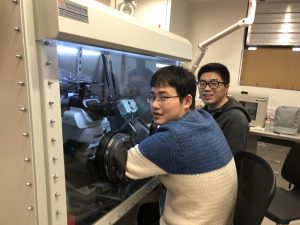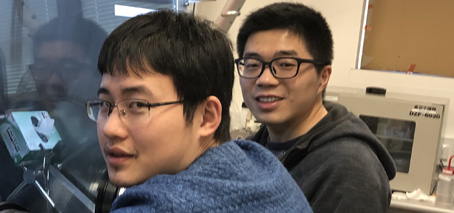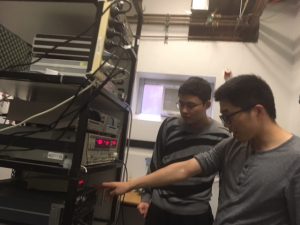FLEET RMIT—UNSW collaboration measuring transport properties of van der Waals heterostructures

Cheng Tan (RMIT, left) and Feixiang Xiang (UNSW, right) use a micromanipulator to fabricate hBN-encapsulated WTe2 structures within the oxygen-free, nitrogen atmosphere of a glove-box at RMIT.
FLEET PhD Cheng Tan (RMIT) visited UNSW’s labs in May to perform magnetic coupling measurements on 2D ferromagnetic crystals.
The visit was reciprocated this month with FLEET Research Fellow Feixiang Xiang (UNSW) visiting RMIT to construct van der Waals structures for studying of 2D topological systems.
This collaboration between FLEET researchers from Lan Wang’s group at RMIT and Alex Hamilton’s group at UNSW advances both projects, and also expands the number of viable van der Waals devices studied by FLEET for potential use in future low-energy electronics.
Van der Waals (vdW) materials are made up of many layers, held together by weak forces. The most well-known vdW material is graphite, with the weak connecting forces allowing layers to ‘shear off’, which is why graphite is effectively used in pencil leads.
Cheng and Feixiang both study vdW heterostructures, which comprise a number of different vdW materials.
Cheng Tan (RMIT) studies magnetic coupling within ferromagnetic vdW heterostructures, and was making use of UNSW facilities and expertise to measure the magnetic field dependence of magnetoresistance. Ultimately, this modelling of magnetic coupling within vdW heterostructures will lead to measuring coupling between ferromagnetic vdW flakes and topological insulators, which would be key to achieving quantum anomalous Hall effect in future spintronic devices.
Feixiang Xiang (UNSW) studies electron transport through topological edge states in atomically-thin (two dimensional) crystals of tungsten ditelluride (WTe2), a semimetallic compound. At RMIT, he was constructing protective (‘encapsulating’) casings around the WTe2, which oxidises when exposed to air. The material was encapsulated within hexagonal boron nitride (h-BN) in the inert nitrogen atmosphere of a RMIT glove-box. Back at UNSW, Feixiang will use the new structures to measure the sample resistance at low temperatures and high magnetic fields, looking for the quantised resistance that is characteristic of the quantum spin Hall effect.
The custom dry-transfer system developed by Cheng and Lan Wang’s at RMIT allows fabrication of an ‘almost infinite’ variety of vdW heterostructures for FLEET’s Research themes 1 and 2.
Nanofabrication at FLEET
FLEET’s research sits at the very boundary of what is possible in condensed-matter physics. At the nano scale, nanofabrication of functioning devices will be key to the Centre’s success.
Specialised techniques needed to integrate novel atomically-thin, two-dimensional (2D) materials into high-quality, high-performance nano-devices are coordinated within the Centre’s Enabling technology B, led by RMIT’s Lan Wang.
This collaboration between FLEET’s UNSW and RMIT teams is typical of the Centre’s nano-device research, which links many of FLEET’s groups and nodes. Some groups bring expertise in device fabrication, while other groups are strong in device characterisation. Such teamwork, fundamental to modern science, is expedited by the Australian Research Council Centre of Excellence system.
FLEET is a collaboration of over a hundred researchers at seven Australian universities and 13 Australian and international science organisations, seeking to develop ultra-low energy electronics to face the challenge of energy use in computation, which already consumes 5–8% of global electricity, and is doubling each decade.
The search for topological edge states in WTe2 and magnetic coupling between ferromagnetic vdW materials and topological insulators sits within FLEET’s Research theme 1 (topological insulators), while many of the fabrications methods Cheng and Feixiang developed will also be used within FLEET’s Research theme 2 (exciton superfluids).
More information
- Email Cheng Tan (RMIT) s3536281@student.rmit.edu.au
- Email Feixiang Xiang (UNSW) feixiang.xiang@unsw.edu.au
- Contact Errol Hunt (FLEET) media@fleet.org.au
- Follow @FLEETCentre


